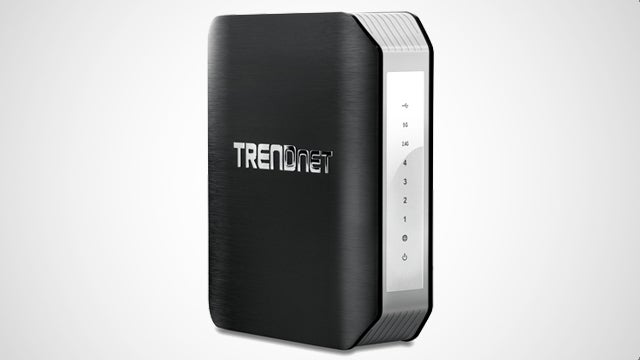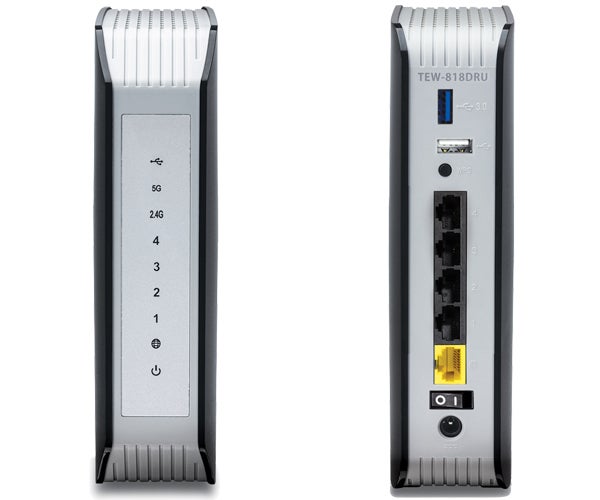TRENDnet TEW-818DRU AC1900 Review
TRENDnet TEW-818DRU AC1900
One of the fastest router's we've tested and at a breakthrough price

Sections
- Page 1 TRENDnet TEW-818DRU AC1900 Review
- Page 2 Setup & Performance Review
Verdict
Pros
- AC1900 wireless performance on a budget
- Extremely strong 802.11n 2.4GHz speeds
- Incredible value
Cons
- Uninspiring looks
- Slightly outdated setup process
Key Specifications
- Review Price: £119.99
- 802.11a/b/g/n/ac 2.4GHz & 5GHz WiFi
- 4x Gigabit LAN
- 1x Gigabit WAN
- 1x USB 2.0, 1x USB 3.0
- WPS, WPA/WPA2 security
What is the TRENDnet TEW-818DRU AC1900?
In short: a surprise. TRENDnet has carved out a great niche for itself in recent years by making very good routers with budget friendly price tags. Take the TEW-812DRU for example, it bests most decent 802.11ac routers and at roughly £100 costs a third less. But now the company is stepping things up. The 818DRU shares the same cutting edge ‘AC1900’ Broadcom chipset as flagship routers from Linksys, Asus and Netgear that near £200, but yet again keeps keep the price much closer to £100.
Has TRENDnet just evolved from the bargain brand of choice to the brand of choice?
SEE ALSO: Best Routers
TRENDnet TEW-818DRU: Design
From the outside you’d conclude not. To put it kindly the 818DRU is no looker and it shares the same chassis as the cheaper 812DRU. This means a reasonably nice textured, dark pseudo metal finish on the sides but an ugly beige middle that seems to be inspired by PC towers of the 1980s.
The flip side in using the same chassis is TRENDnet has managed to somehow squeeze its beefier internals into the same 180 x 155 x 48mm dimensions and kept the weight at just 395g. The 812DRU was already small and light for an AC1750 router, so the 818DRU is positively miniscule for an AC1900 one.

TRENDnet TEW-818DRU: Features
But looks are not what interest us when a router comes with Broadcom’s blockbuster BCM4708A chipset. To recap, the unusual ‘AC1900’ branding comes from Broadcom’s proprietary ‘Turbo QAM’ technology, which boosts legacy 802.11n 2.4GHz speeds from a previous theoretical maximum of 450Mbps to 600Mbps. When this is added to the 1300Mbps theoretical maximum of full fat 802.11ac you get the 1900Mbps figure only it, the Netgear R7000 Nighthawk, Asus RT-AC68U and Linksys EA6900 can claim. All three are streets ahead of any AC1750 routers we have tested.
There is an obvious area corner cut by TRENDnet though: whereas the other three all have external, upgradeable dipoles the 818DRU is fitted with internal antennas. Some dismiss external antennas as more show than go, which sets up an intriguing test, but it isn’t the only area TRENDnet has seen fit to trim.
Hardware specs have been curtailed too. Compared to its rivals the 818DRU halves RAM to 128MB and internal flash memory from 128MB to 16MB. These reductions can affect both performance at range and USB speeds over a network. There is also one USB 2.0 port and one USB 3.0 port like Asus and Netgear, though Linksys made both ports USB 3.0 on the EA6900.
Elsewhere everything measures up. There are 4x Gigabit LAN and 1x Gigabit WAN, WPS, WPA/WPA2 security, PAC (Parental Access Controls), QoS management, IPv6 support, Dynamic DNS and FTP server support. TRENDnet doesn’t offer remote cloud control like Linksys and – to a lesser extent – D-Link and Asus, but security risks mean that is as much of a deal maker as deal breaker in some eyes.
In short, the 818DRU does make compromises, but if it can keep relatively close to its far more expensive rivals it will prove the far better buy for most.

